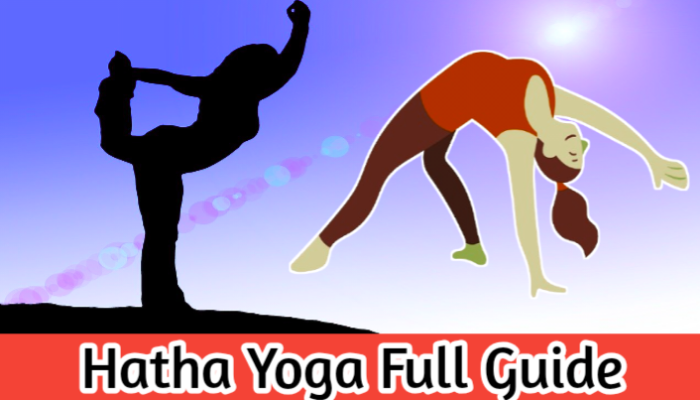Hatha Yoga is a traditional form of yoga that focuses on physical postures (asanas), breathing techniques (pranayama), and mental relaxation. The term “Hatha” comes from Sanskrit: “Ha” means sun and “Tha” means moon, symbolizing the balance of body and mind, strength and flexibility, effort and relaxation.
1. History and Origins of Hatha Yoga
- Originated in ancient India, around 11th century
- Developed by yogis to prepare the body and mind for meditation
- Focused on discipline, physical health, and spiritual development
- Foundation for many modern yoga styles, including Vinyasa, Power, and Iyengar Yoga
2. Principles of Hatha Yoga
2.1 Balance of Sun (Ha) and Moon (Tha)
- Balances energy: active (sun) vs. passive (moon)
- Promotes harmony in body, mind, and emotions
2.2 Breath Awareness (Pranayama)
- Controlled breathing supports energy flow, concentration, and relaxation
2.3 Physical Postures (Asanas)
- Poses improve strength, flexibility, and posture
- Prepares the body for meditation and mental focus
2.4 Mental and Emotional Focus
- Encourages mindfulness, stress reduction, and emotional stability
3. Benefits of Hatha Yoga
3.1 Physical Benefits
- Increases flexibility, strength, and balance
- Improves posture and spinal alignment
- Boosts circulation and energy levels
- Supports digestion and metabolism
3.2 Mental Benefits
- Reduces stress, anxiety, and mental fatigue
- Improves concentration and mindfulness
- Enhances emotional resilience and mental clarity
3.3 Spiritual Benefits
- Promotes inner peace and self-awareness
- Prepares the mind for meditation and spiritual growth
4. Common Hatha Yoga Poses (Asanas)
4.1 Standing Poses
- Mountain Pose (Tadasana)
- Warrior I & II (Virabhadrasana)
- Triangle Pose (Trikonasana)
4.2 Sitting and Forward Bends
- Seated Forward Bend (Paschimottanasana)
- Bound Angle Pose (Baddha Konasana)
4.3 Backbends
- Cobra Pose (Bhujangasana)
- Bridge Pose (Setu Bandhasana)
4.4 Twists and Balance Poses
- Half Lord of the Fishes Pose (Ardha Matsyendrasana)
- Tree Pose (Vrikshasana)
4.5 Relaxation Poses
- Corpse Pose (Savasana)
- Child’s Pose (Balasana)
5. Breathing Techniques (Pranayama)
5.1 Basic Techniques
- Deep Diaphragmatic Breathing: Increases oxygen and relaxes the body
- Alternate Nostril Breathing (Nadi Shodhana): Balances energy and calms the mind
5.2 Benefits of Pranayama
- Reduces anxiety and stress
- Improves lung capacity
- Enhances focus and mental clarity
6. Step-by-Step Hatha Yoga Routine
6.1 Warm-Up (5–10 minutes)
- Gentle stretches: Neck rolls, shoulder rotations, Cat-Cow Pose
- Prepares muscles and joints for asanas
6.2 Core Asanas (20–30 minutes)
- Standing poses: Warrior I & II, Triangle Pose
- Sitting poses: Forward bends, twists
- Backbends: Cobra, Bridge
- Balance poses: Tree Pose
6.3 Cool Down (5–10 minutes)
- Seated stretches and gentle forward bends
- Finish with Savasana for relaxation and mind-body integration
7. Tips for Practicing Hatha Yoga
7.1 Start Slowly
- Focus on alignment and form rather than speed
- Use props (blocks, straps, cushions) if needed
7.2 Consistency is Key
- Practice 3–5 times per week for best results
- Even 20–30 minutes daily can bring significant benefits
7.3 Mindful Breathing
- Synchronize breath with movement
- Focus on deep, steady breathing for calmness and energy flow
7.4 Listen to Your Body
- Avoid pushing beyond comfort or flexibility limits
- Modify poses if experiencing pain or discomfort
8. Who Should Practice Hatha Yoga?
- Beginners seeking a gentle introduction to yoga
- Individuals aiming for stress reduction and mental clarity
- People looking to improve flexibility, balance, and posture
- Suitable for all ages, including seniors (with modifications)
9. Conclusion
Hatha Yoga is a holistic practice that balances physical strength, mental clarity, and spiritual growth. By combining asanas, pranayama, and mindfulness, practitioners can:










